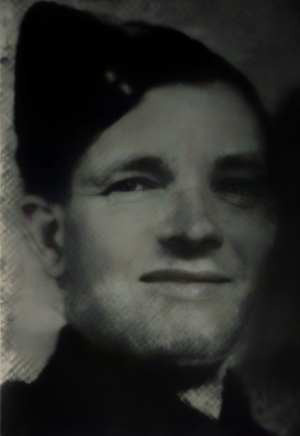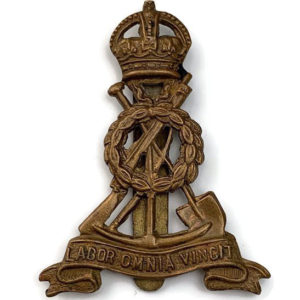
Lewis Hidle was born in Morley on 6th June 1907, the fifth born child and third son of George Hidle (1876-1939) a cloth finisher and tenterer and his wife Mary Ann. George aged 21 years and 20 years old Mary Ann Whitwam (1877-1940), both of Woodkirk at the time of their marriage, were joined together at St. Mary’s Church, Woodkirk on 28th May 1898. By 1901 the couple were living on Middleton Road, Morley where seven of their children were born. The couple went on to have twelve children from their marriage but sadly only seven children, including twins, survived beyond 1917.
In 1910 the family moved from Morley to live at South Parade, Ossett where George Hidle worked as a coal hewer at one of the local collieries; quite possibly Old Roundwood which was but a short walk along Haggs Lane. George’s wife Mary Ann, by this time a mother of five surviving children under the age of 11, was a cloth weaver. Three of the couple’s children were at school. Mary Ann’s father, 55 years old Mark Whitwam also a coal hewer was also living in the household.
The family Hidle’s residence in Ossett was short lived and by early 1913 George, Mary Ann and five of their seven surviving children, including 14 years old Lewis, had moved from Ossett to 4, Ferrand’s Yard, Horbury. By 1921 George, had his own news agency and two of his sons, Mark (aged 18) and Joe (aged 16) were working as coal hurriers at the Netherton British Oak Colliery owned by Abraham Brooke & Sons since 1876. The Colliery closed in 1923. Lewis, aged 14, appears to have been between schooling and work since he records neither in the 1921 Census. For the rest of the 1920’s and the early 1930’s George, Mary Ann, Lewis and the twins, George and Rose, continued to live at number 4, Ferrand’s Yard, Horbury.
On 17th June 1931 the 23 years old Lewis Hidle married his 20 years old bride Doreen Smith of 4, Albion Street, Ings Road, Wakefield at West Parade Chapel, West Parade, Wakefield. Lewis was working as an engineer’s fitter, but later worked for Horbury Council as a scavenger, better known today as a dustman, street cleaner or refuse collector. By 1934 Lewis and Doreen (born 9th November 1910) had moved to 23, South Avenue, Horbury which was their home until 1937 when they moved to Fern Cottage, Tithebarn Street, Horbury.
Lewis’ father, George Hidle, newsagent of 40, New Street, Horbury, died aged 62 years and was buried at Horbury on 14th January 1939. New Street had been home for five years for George, Mary Ann and other family members. He left a widow, Mary Ann, who also sadly passed away, suddenly, on 22nd April 1940, aged 63 years Mary Ann was buried at Horbury on 24th April 1940.
On 1st September 1939 Nazi Germany invaded Poland and two days later, on 3rd September 1939, Great Britain and France declared war on Germany. At the outbreak of what came to be known as World War II, the government urgently needed to know everything it could about the civil population of England and Wales. This information would be key in the issuing of identity cards and ration books as well as organising conscription and, after the war, creating the N.H.S. To gather this information, a National Register was taken and on September 29th, 1939, the personal details – including names, dates of birth, occupations, marital statuses – of 41 million individuals were recorded.
The Register recorded that Lewis and Doreen Hidle were living at 22, Highfield Horbury with three of their four daughters, Sheila, born early 1934, Vera Ann, born summer 1935 and Brenda, born early 1938. Their fourth daughter, Doreen, was born in summer 1942. Another family member, Violet Hidle born 1917, was also living with the couple. The National Register recorded that Lewis was still scavenging for Horbury Council and was described as a “heavy worker”. In addition, he had joined the Air Raid Precautions as a warden. His main task was to guide and protect people during air raids, when enemy planes dropped bombs, especially on towns and cities. ARP’s would also hand out gas masks and guide people to shelters. It was to prove prescient.
At some stage in 1940 Lewis Hidle enlisted with the Royal Regiment of Artillery and was allotted service number 1094931. His attestation was cancelled on 13th November 1940 under a heading of “…cause of becoming non effective…..” but there is no further explanation. We may never know but perhaps the cancellation was on compassionate grounds bearing in mind that Lewis had lost both of his parents in 15 months between January 1939 and April 1940. At the time of the cancellation Lewis was also the father of three young daughters, aged six years and under.
Perhaps Lewis was being granted temporary furlough but in any event he subsequently served in WWII with the Pioneer Corps with service number 13089812. The Corps needed men who, like Lewis, had experience of heavy work.
 Left Cap badge, Pioneer Corps, 1943 depicts a crossed rifle, shovel & pick with a laurel wreath piled on them, ensigned by a monarchical crown. The regimental motto ‘Labor Omnia Vincit’ (Work Conquers All).
Left Cap badge, Pioneer Corps, 1943 depicts a crossed rifle, shovel & pick with a laurel wreath piled on them, ensigned by a monarchical crown. The regimental motto ‘Labor Omnia Vincit’ (Work Conquers All).
The Pioneer Corps performed many tasks in all theatres of war. Handling stores, laying prefabricated track on the beaches, anti-aircraft emplacements, mine clearance, guarding bases and stretcher-bearing. They constructed airfields, roads and erected bridges. Many thousands of Germans and Austrians joined the Pioneer Corps to assist the Allied war efforts and liberation of their home countries.
In September 1939, Works Labour Companies were formed from Reservists. A month later, these were grouped together to form the Auxiliary Military Pioneer Corps (AMPC). From its inception, this was ranked as a combatant unit – a status no previous pioneer unit had achieved. In June 1940, many of the AMPC’s companies had to be pressed into use as combat troops during the Battle of France(1940), before being evacuated. In November 1940, the unit was renamed the Pioneer Corps and its recruits included Jewish and anti-Nazi refugees who had fled from Austria, Germany and Eastern Europe.
The number of German-born Jews joining the British forces was exceptionally high and risky since, in the case of them being taken captive, there was a high probability they would have been executed as traitors by the Germans. Until the end of the war, one in seven Jewish refugees from Germany had joined the British forces.
It has not been possible to determine with any certainty when Lewis joined the Pioneer Corps but it is unlikely to be earlier than 1941 and, if Lewis was serving overseas, it may have been after the birth of his youngest child, Doreen, in summer 1942.
Private Lewis Hidle of the Pioneer Corps was killed in action at Strood, Rochester, Kent on 2nd March 1944 in an enemy air raid. He was 36 years old, a husband and a father of four daughters, none of whom were older than ten years. That he was killed in an air raid so far from home serving with his Regiment was not only very sad but also ironic since in 1939 he had joined the local Air Raid Precautions Unit to ensure the safety of those close to his home in Horbury in similar circumstances.
The attack on Strood was part of Operation Steinbock which was a strategic bombing campaign London and the south east by Nazi Germany which lasted from January to May 1944.Steinbock was to be the enemy’s final strategic air offensive in WWII. It was a response to the allies bombing campaign against German industrial cities and ordered by Hitler to provide propaganda to the war weary German public.
It is likely that the purpose of the attack was the railway line and not the houses in Station Road, Strood and therefore the bombs had missed their target. The trains were certainly running London bound the following day. Victoria Station, London was another target that night and had caused significant damage to parts of London. 300 people were left homeless by the worst attack in the Strood area during WWII.
Around 1000 buildings were damaged including 74 shops, a church, two schools and several public houses. At this stage of the war many people had become relaxed about sleeping in the comfort of their homes. This had increased the number of casualties as people were not using the Anderson shelters. It is believed that there was approximately 18 Civilian War Dead, 14 of whom are remembered by the CWGC at Rochester. In addition three servicemen, Lewis Hidle and two of his friends were believed to have been killed during the raid. Two men of the Pioneer Corps were killed in action on that day; Lewis and William Newton who is buried at Carlton, Nottinghamshire. Another 30 men, women and children were injured.
The WW2 People’s War story below was contributed in 2002 by Brenda Wigglesworth who is the daughter of Lewis and Doreen Hidle.
Private Lewis Hidle, 13089812, Pioneer Corps was killed in action in an enemy air raid on Strood, Rochester, Kent on 2nd March 1944. He was 36 years old and left a widow, Doreen and four daughters, Sheila, Vera Ann, Brenda and Doreen, aged ten years and under .
Lewis is buried at Horbury Cemetery, Section H, Grave 395 marked by a Commonwealth War Graves Commission Headstone which was first raised in 1956. Following his widow’s death on 2nd November 1998 the Headstone now also bears her name, Doreen. Lewis Hidle is also remembered on the Horbury Memorial and his name is engraved at the Ossett War Memorial in the Market Place alongside his brothers and sisters in arms; The Ossett Fallen.
Photograph Courtesy of Helen Bickerdike
Our thanks to the Chatham Historic Society for the photograph of the damage at Station Road Strood and for the Society’s research and publication of the Strood Air Raid on 2nd March 1944.
This biography was researched and written in September 2022 for the Ossett Heritage website.